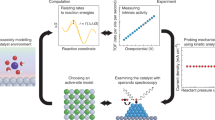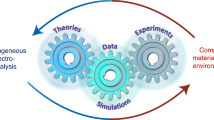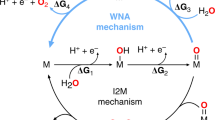Abstract
There is a need for the quantitative assessment of molecular electrocatalysts, particularly those designed to address modern energy challenges. This calls for systematic benchmarking to help rationalize the wealth of available data and to apply the lessons learnt to the innovative design of more efficient catalysts. For these purposes, it is tempting to examine the relationship between the reaction kinetics and the stabilization of a single primary intermediate by constructing a volcano plot. The attractiveness and inherent flaw in this oversimplified approach stem from accounting for complicated multi-electron, multistep processes with a single descriptor. In this Perspective, we instead advocate correlating the turnover frequency with the overpotential through a catalytic Tafel plot, which provides a much less restrictive and more reliable evaluation of intrinsic catalyst performance. Within this framework, one way to optimize molecular catalysts involves altering ligand substituents to tune the electronic structure of the catalyst. These inductive through-structure effects are subject to an ‘iron law’, which dictates that gains in the form of smaller overpotentials come at the price of reduced turnover frequencies (and vice versa). This law can be circumvented by instead engineering through-space effects that stabilize the primary catalytic intermediate. These considerations should be based on the patient gathering of reliable experimental data obtained upon variation of the maximal number of operational parameters.
This is a preview of subscription content, access via your institution
Access options
Access Nature and 54 other Nature Portfolio journals
Get Nature+, our best-value online-access subscription
$29.99 / 30 days
cancel any time
Subscribe to this journal
Receive 12 digital issues and online access to articles
$119.00 per year
only $9.92 per issue
Buy this article
- Purchase on Springer Link
- Instant access to full article PDF
Prices may be subject to local taxes which are calculated during checkout






Similar content being viewed by others
References
Hoffert, M. I. et al. Energy implications of future stabilization of atmospheric CO2 content. Nature 395, 881–884 (1998).
Lewis, N. S. & Nocera, D. G. Powering the planet: chemical challenges in solar energy utilization. Proc. Natl Acad. Sci. USA 103, 15729–15735 (2006).
Gray, H. B. Powering the planet with solar fuel. Nat. Chem. 1, 7 (2009).
Nocera, D. G. Chemistry of personalized solar energy. Inorg. Chem. 48, 10001–10017 (2009).
Abbott, D. Keeping the energy debate clean: how do we supply the world’s energy needs? Proc. IEEE 98, 42–66 (2010).
Chu, S. & Majumdar, A. Opportunities and challenges for a sustainable energy future. Nature 488, 294–303 (2012).
Artero, V. & Fontecave, M. Solar fuels generation and molecular systems: is it homogeneous or heterogeneous catalysis? Chem. Soc. Rev. 42, 2338–2356 (2013).
Bligaard, T. et al. Toward benchmarking in catalysis science: best practices, challenges, and opportunities. ACS Catal. 6, 2590–2602 (2016).
Costentin, C., Drouet, S., Robert, M. & Savéant, J.-M. Turnover numbers, turnover frequencies, and overpotential in molecular catalysis of electrochemical reactions. Cyclic voltammetry and preparative-scale electrolysis. J. Am. Chem. Soc. 134, 11235–11242 (2012).
Savéant, J.-M. & Vianello, E. in Advances in Polarography 1st edn (ed. Longmuir, I. S. ) 367–374 (Pergamon Press, 1960).
Savéant, J.-M. Elements of Molecular and Biomolecular Electrochemistry: An Electrochemical Approach to Electron Transfer Chemistry (Wiley, 2006).
Costentin, C. & Savéant, J.-M. Multielectron, multistep molecular catalysis of electrochemical reactions: benchmarking of homogeneous catalysts. ChemElectroChem 1, 1226–1236 (2014).
Bard, A. J. & Faulkner, L. R. Electrochemical Methods: Fundamentals and Applications 2nd edn (Wiley, 2001).
Rigsby, M. L., Wasylenko, D. J., Pegis, M. L. & Mayer, J. M. Medium effects are as important as catalyst design for selectivity in electrocatalytic oxygen reduction by iron-porphyrin complexes.J. Am. Chem. Soc. 137, 4296–4299 (2015).
Steffey, B. D. et al. Synthesis and characterization of palladium complexes containing tridentate ligands with PXP (X = C, N, O, S, As) donor sets and their evaluation as electrochemical CO2 reduction catalysts. Organometallics 13, 4844–4855 (1994).
Costentin, C., Robert, M. & Savéant, J.-M. Current issues in molecular catalysis illustrated by iron porphyrins as catalysts of the CO2-to-CO electrochemical conversion. Acc. Chem. Res. 48, 2996–3006 (2015).
Martin, D. J., McCarthy, B. D., Rountree, E. S. & Dempsey, J. L. Qualitative extension of the EC′ zone diagram to a molecular catalyst for a multi-electron, multi-substrate electrochemical reaction. Dalton Trans. 45, 9970–9976 (2016).
Elgrishi, N., McCarthy, B. D., Rountree, E. S. & Dempsey, J. L. Linear free energy relationships in the hydrogen evolution reaction: kinetic analysis of a cobaloxime catalyst. ACS Catal. 6, 3326–3335 (2016).
Costentin, C., Robert, M., Savéant, J.-M. & Tard, C. Breaking bonds with electrons and protons. Models and examples. Acc. Chem. Res. 47, 271–280 (2014).
Costentin, C., Passard, G., Robert, M. & Savéant, J.-M. Pendant acid–base groups in molecular catalysts: H-bond promoters or proton relays? Mechanisms of the conversion of CO2 to CO by electrogenerated iron(0) porphyrins bearing prepositioned phenol functionalities. J. Am. Chem. Soc. 136, 11821–11829 (2014).
Costentin, C., Dridi, H. & Savéant, J.-M. Molecular catalysis of H2 evolution: diagnosing heterolytic versus homolytic pathways. J. Am. Chem. Soc. 136, 13727–13734 (2014).
Mondal, B., Rana, A., Sen, P. & Dey, A. Intermediates involved in the 2e−/2H+ reduction of CO2 to CO by iron(0) porphyrin. J. Am. Chem. Soc. 137, 11214–11217 (2015).
Azcarate, I., Costentin, C., Robert, M. & Savéant, J.-M. Dissection of electronic substituent effects in multielectron–multistep molecular catalysis. Electrochemical CO2-to-CO conversion catalyzed by iron porphyrins. J. Phys. Chem. C 120, 28951–28960 (2016).
Pegis, M. L. et al. Homogenous electrocatalytic oxygen reduction rates correlate with reaction overpotential in acidic organic solutions. ACS Cent. Sci. 2, 850–856 (2016).
Bhugun, I., Lexa, D. & Savéant, J.-M. Catalysis of the electrochemical reduction of carbon dioxide by iron(0) porphyrins: synergistic effect of weak Brønsted acids. J. Am. Chem. Soc. 118, 1769–1776 (1996).
Azcarate, I., Costentin, C., Robert, M. & Savéant, J.-M. Through-space charge interaction substituent effects in molecular catalysis leading to the design of the most efficient catalyst of CO2-to-CO electrochemical conversion. J. Am. Chem. Soc. 138, 16639–16644 (2016).
Frushicheva, M. P. et al. Computer aided enzyme design and catalytic concepts. Curr. Opin. Chem. Biol. 21, 56–62 (2014).
Sabatier, P. La catalyse en chimie organique [French] (Librairie Polytechnique, 1920).
Parsons, R. The rate of electrolytic hydrogen evolution and the heat of adsorption of hydrogen. Trans. Faraday Soc. 54, 1053–1063 (1958).
Gerischer, H. Mechanismus der elektrolytischen Wasserstoffabscheidung und Adsorptionsenergie von atomarem Wasserstoff [German]. Bull. Soc. Chim. Belg. 67, 506–527 (1958).
Koper, M. T. M. Analysis of electrocatalytic reaction schemes: distinction between rate-determining and potential-determining steps. J. Solid State Electrochem. 17, 339–344 (2013).
Quaino, P., Juarez, F., Santos, E. & Schmickler, W. Volcano plots in hydrogen electrocatalysis — uses& abuses. Beilstein J.Nanotechnol. 5, 846–854 (2014).
Zeradjanin, A. R., Grote, J.-P., Polymeros, G. & Mayrhofer, K. J. A critical review on hydrogen evolution electrocatalysis: re-exploring the volcano-relationship. Electroanalysis 28, 2256–2269 (2016).
Savéant, J.-M. Molecular catalysis of electrochemical reactions. Mechanistic aspects. Chem. Rev. 108, 2348–2378 (2008).
Costentin, C. & Savéant, J.-M. Homogeneous molecular catalysis of electrochemical reactions: catalyst benchmarking and optimization strategies. J. Am. Chem. Soc. 139, 8245–8250 (2017).
Garreau, D. & Savéant, J.-M. Linear sweep voltammetry — compensation of cell resistance and stability: determination of the residual uncompensated resistance. J. Electroanal. Chem. Interfacial Electrochem. 35, 309–331 (1972).
Liu, C. P., Liu, T. B. & Hall, M. B. Influence of the density functional and basis set on the relative stabilities of oxygenated isomers of diiron models for the active site of [FeFe]-hydrogenase. J. Chem. Theory Comput. 11, 205–214 (2015).
Kumar, M. & Kozlowski, P. M. Electronic and structural properties of cob(I)alamin: ramifications for B12-dependent processes. Coord. Chem. Rev. 333, 71–81 (2017).
Renault, C. et al. Unraveling the mechanism of catalytic reduction of O2 by microperoxidase-11 adsorbed within a transparent 3D-nanoporous ITO film. J. Am. Chem. Soc. 134, 6834–6845 (2012).
Chatterjee, S., Sengupta, K., Mondal, B., Dey, S. & Dey, A. Factors determining the rate and selectivity of 4e−/4H+ electrocatalytic reduction of dioxygen by iron porphyrins complexes. Acc. Chem. Res. 50, 1744–1753 (2017).
Costentin, C., Drouet, S., Passard, G., Robert, M. & Savéant, J.-M. Proton-coupled electron transfer cleavage of heavy-atom bonds in electrocatalytic processes. Cleavage of a C–O bond in the catalyzed electrochemical reduction of CO2 . J. Am. Chem. Soc. 135, 9023–9031 (2013).
Sampson, M. D. et al. Manganese catalysts with bulky bipyridine ligands for the electrocatalytic reduction of carbon dioxide: eliminating dimerization and altering catalysis. J. Am. Chem. Soc. 136, 5460–5471 (2014).
Author information
Authors and Affiliations
Contributions
Both authors contributed equally to the preparation of this manuscript.
Corresponding authors
Ethics declarations
Competing interests
The authors declare no competing interests.
Rights and permissions
About this article
Cite this article
Costentin, C., Savéant, JM. Towards an intelligent design of molecular electrocatalysts. Nat Rev Chem 1, 0087 (2017). https://doi.org/10.1038/s41570-017-0087
Published:
DOI: https://doi.org/10.1038/s41570-017-0087
This article is cited by
-
Interfacial Electronic Modulation of Dual-Monodispersed Pt–Ni3S2 as Efficacious Bi-Functional Electrocatalysts for Concurrent H2 Evolution and Methanol Selective Oxidation
Nano-Micro Letters (2024)
-
Precisely Control Relationship between Sulfur Vacancy and H Absorption for Boosting Hydrogen Evolution Reaction
Nano-Micro Letters (2024)
-
Dual-phase MoS2/MXene/CNT ternary nanohybrids for efficient electrocatalytic hydrogen evolution
npj 2D Materials and Applications (2022)
-
Engineering a local acid-like environment in alkaline medium for efficient hydrogen evolution reaction
Nature Communications (2022)
-
Adsorbed cobalt porphyrins act like metal surfaces in electrocatalysis
Nature Catalysis (2022)



